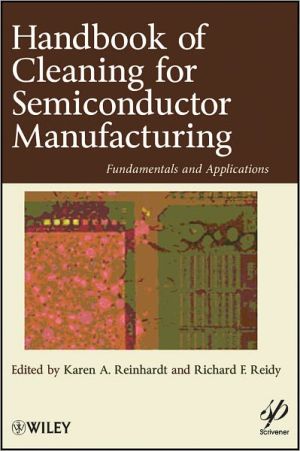

 |

|

Sold Out
Book Categories |
Foreword.
Introduction.
Part 1: Fundamentals.
1. Surface and Colloidal Chemical Aspects of Wet Cleaning (Srtni Raghavan, Manish Keswani, and Nandini Venkataraman).
1.1 Introduction to Surface Chemical Aspects of Cleaning.
1.2 Chemistry of Solid-Water Interface.
1.3 Particulate Contamination: Theory and Measurements.
1.4 Influence of Surface Electrical Charges on Metal Ion Adsorption.
1.5 Wettability of Surfaces.
1.6 High Aspect Ratio Cleaning: Narrow Structures.
1.7 Surface Tension Gradient: Application to Drying.
1.8 Summary.
2. The Chemistry of Wet Cleaning (D. Martin Knotter).
2.1 Introduction to Aqueous Cleaning.
2.2 Overview of Aqueous Cleaning Processes.
2.3 The SC-1 Clean or APM.
2.4 The SC-2 clean or HPM.
2.5 Sulfuric Acid-Hydrogen Peroxide Mixture.
2.6 Hydrofluoric Acid.
The Chemistry of Wet Etching (D. Martin Knotter).
3.1 Introduction and Overview.
3.2 Silicon Dioxide Etching.
3.3 Silicon Etching.
3.4 Silicon Nitride Etching.
4. Surface Phenomena: Rinsing and Drying (Karen A. Reinhardt, Richard F. Reidy, and John A. Marsella).
4.1 The Surface Phenomena of Rinsing and Drying.
4.2 Overview of Rinsing.
4.3 Overview of Drying.
5. Fundamental Design of Chemical Formulations (Robert J. Rovito, Michael B. Korzenski, Ping Jiang, and Karen A. Reinhardt).
5.1 Introduction and Overview.
5.2 Historical Development of Formulations for the Integrated Circuit Industry.
5.3 Mechanism of Stripping, Cleaning, and Particle Removal.
5.4 Components and Additives in Chemical Formulations.
5.5 Creating Chemical Formulations.
5.6 Environmental, Safety, and Health Aspects.
Filtering, Recirculating, Reuse, and Recycling of Chemicals (Barry Gotlinsky, Kevin T. Pate, and Donald C. Grant).
6.1 Overview of Wet Chemical Contamination Control 193
6.2 Bulk Chemical Distribution for Wet Cleaning Tools.
6.3 Chemical Distribution, Filtering, and Recirculation.
6.4 Contamination Control Metrology.
6.5 Effects of Contamination.
6.6 Filtration.
6.7 Chemical Blending, Recycling, and Reuse.
6.8 Summary.
Part 2: Applications.
7. Cleaning Challenges of High-K/Metal Gate Structures (Muhammad M. Hussain, Denis Shamiryan, Vasile Paraschiv, Kenichi Sano, and Karen A. Reinhardt).
7.1 Introduction and Overview of High-k/Metal Gate Surface Preparation.
7.2 Surface Preparation and Cleaning.
7.3 Wet Film Removal.
7.4 High-K Removal.
7.5 Resist Stripping and Residue Removal.
High Dose Implant Stripping (Karen A. Reinhardt and Michael B. Korzenski).
8.1 Introduction and Overview of High Dose Implant Stripping.
8.2 High Dose Implant Cleaning and Stripping Processes.
8.3 Plasma Processing.
8.4 Wet Processing.
8.5 Other Processing.
Aluminum Interconnect Cleaning and Drying (David J. Maloney).
9.1 Introduction to Aluminum Interconnect Cleaning.
9.2 Source of Post-Etch Residues Requiring Wet Cleaning.
9.3 Chemistry Considerations for Cleans Following Etching.
9.4 Rinsing/Drying and Equipment Considerations.
9.5 Alternative and Emerging Cleaning Technologies.
10. Low-k/CU Cleaning and Drying (Karen A. Reinhardt, Richard F. Reidy, and Jerome Daviot).
10.1 Introduction and Overview.
10.2 Stripping and Post-etch Residue Removal.
10.3 Pore Sealing and Plasma Damage Repair.
10.4 Post-chemical Mechanical Polishing Cleaning.
11. Corrosion and Passivation of Copper (Darryl W. Peters).
11.1 Introduction and Overview 395
11.2 Copper Corrosion.
11.3 Copper Corrosion Inhibitors.
11.4 Copper Cleaning Formulations.
12. Germanium Surface Conditioning and Passivation (Sonja Sioncke, Yves J. Chabal, and Martin M. Frank).
12.1 Introduction.
12.2 Germanium Cleaning.
12.3 Surface Passivation and Gate Stack Interface Preparation.
13. Wafer Reclaim (Michael B. Korzenski and Ping Jiang).
13.1 Introduction to Wafer Reclaim.
13.2 Introduction to Silicon Manufacturing for Semiconductor Applications.
13.3 Energy Requirements for Silicon Wafer Manufacturing.
13.4 Test Wafer Usage and Wafer Reclaim.
13.5 Requirements for Wafer Reclaim and Recycle.
13.6 Wafer Reclaim Options.
13.7 Types of Wafer Reclaim Processes.
13.8 Formulated Reclaim Solutions.
14. Direct Wafer Bonding Surface Conditioning (Hubert Moriceau, Yannick C. Le Tiec, Frank Fournel, Ludovic F. L. Ecarnot, Sébastien L. E. Kerdilès, Daniel Delprat, and Christophe Maleville).
14.1 Introduction and Overview of Bonding.
14.2 Planarization and Smoothing Prior to Bonding.
14.3 Wet Cleaning and Surface Conditioning Processing.
14.4 Dry Surface Conditioning Processing.
14.5 Thermal Treatments and Annealing.
14.6 Conductive Bonding.
Part 3: New Directions.
15. Novel Analytical Methods for Cleaning Evaluation (Chris M. Sparks and Alain C. Diebold).
15.1 Introduction.
15.2 Novel Analytical Methods.
15.3 Recent Advances in Total Reflection X-ray Fluorescence Spectroscopy Analysis.
15.4 Advances in Vapor Phase Analysis.
15.5 Trace Metal Contamination on the Edge and Bevel of a Wafer.
15.6 Kelvin Probe Technologies.
15.7 Novel Applications of Electron Spectroscopy Techniques.
15.8 Novel X-ray Spectroscopy Techniques.
15.9 Electrochemical Sensors.
15.10 Summary.
16. Stripping and Cleaning for Advanced Photolithography Applications (John A. Marsella, Dana L. Durham, and Leslie D. Molnar).
16.1 Introduction to Advance Stripping Applications.
16.2 Historical Background.
16.3 Recent Trends for Photoresist Stripping and Post-etch Residue Removal.
16.4 Single Wafer Tools.
16.5 Wetting in Small Dimensions and Cleaning Challenges.
16.6 Environmental Health and Safety.
16.7 The Future of Advanced Photoresist Stripping and Cleaning.
Index.
Login|Complaints|Blog|Games|Digital Media|Souls|Obituary|Contact Us|FAQ
CAN'T FIND WHAT YOU'RE LOOKING FOR? CLICK HERE!!! X
 You must be logged in to add to WishlistX
 This item is in your Wish ListX
 This item is in your CollectionHandbook for Cleaning for Semiconductor Manufacturing: Fundamentals and Applications
X
 This Item is in Your InventoryHandbook for Cleaning for Semiconductor Manufacturing: Fundamentals and Applications
X
 You must be logged in to review the productsX
 X
 X

Add Handbook for Cleaning for Semiconductor Manufacturing: Fundamentals and Applications, This comprehensive volume provides an in-depth discussion of the fundamentals of cleaning and surface conditioning of semiconductor applications such as high-k/metal gate cleaning, copper/low-k cleaning, high dose implant stripping, and silicon and SiGe p, Handbook for Cleaning for Semiconductor Manufacturing: Fundamentals and Applications to the inventory that you are selling on WonderClubX
 X

Add Handbook for Cleaning for Semiconductor Manufacturing: Fundamentals and Applications, This comprehensive volume provides an in-depth discussion of the fundamentals of cleaning and surface conditioning of semiconductor applications such as high-k/metal gate cleaning, copper/low-k cleaning, high dose implant stripping, and silicon and SiGe p, Handbook for Cleaning for Semiconductor Manufacturing: Fundamentals and Applications to your collection on WonderClub |